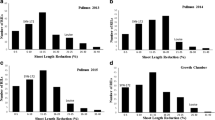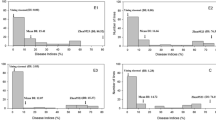Abstract
A 58-point genetic map was constructed with RFLP, RAPD, isozyme, morphological, and disease-resistance markers spanning 766 cM on ten linkage groups for a cross within the cultivated cucumber (Cucumis sativus var. sativus). Relatively few DNA polymorphisms were detected, agreeing with previous studies documenting a narrow genetic base for cucumber. Most RFLPs within the cultivated cucumber appear to be changes at restriction-enzyme sites. Sixty-four percent of RAPD markers that fit expected ratios at P<0.001 were unlinked, possibly due to poor amplification and the inefficiency of dominant markers to detect linkage in an F2 family. A 70-point linkage map, spanning 480 cM on ten linkage groups, was constructed with RFLP, isozyme, morphological, and diseaseresistance markers for a cross between the cultivated cucumber and the wild or feral C. sativus var. hardwickii. Unlinked markers and more linkage groups than chromosome pairs indicated that both maps were not saturated. Twentyone markers doubly segregated in both families and regions of colinearity were identified.
Similar content being viewed by others
References
Abul-Hayja Z (1975) Multiple disease screening and genetics of resistance in cucumber. PhD thesis. University of Wisconsin-Madison, USA
Abul-Hayja Z, Williams PH, Peterson CE (1975) Independence of scab and bacterial wilt resistance and ten seedling markers in cucumber. HortScience 10:423–424
Allard RW (1956) Formulas and tables to facilitate the calculation of recombination values in heredity. Hilgardia 24:235–278
Allendorf FW, Mitchell N, Ryman N, Stahl G (1977) Isozyme loci in brown trout (Salmon trutta L.): detection and interpretation from population data. Hereditas 86:179–190
Apuya N, Frazier BL, Keim P, Roth EJ, Lark KG (1988) Restriction fragment length polymorphisms as genetic markers in soybean, Glycine max (L.) Merr. Theor Appl Genet 75:889–901
Atsmon D, Tabak C (1979) Comparative effects of gibberellin, silver nitrate, aminoethoxyvinyl-glycine on sexual tendency and ethylene evolution in the cucumber plant (Cucumis sativus L.). Plant Cell Physiol 20:1547–1555
Brewer GB (1970) An introduction to isozyme techniques. Academic Press, New York
Cochran FD (1937) Breeding cucumbers for resistance to downy mildew. Proc Am Soc Hort Sci 35:541–543
Dane F (1983) Cucurbits. In: Tanksley SD, Orten TJ (eds) Isozymes in plant genetics and breeding. Part B. Elsevier, Amsterdam, pp 369–390
Dweikat I, Mackenzie S, Levy M, Ohm H (1993) Pedigree assessment using RAPD-DGGE in cereal crops. Theor Appl Genet 85:497–505
Dijkhuizen A (1994) Application of restriction fragment length polymorphisms for the assessment of genetic variability and study of quantitatively inherited traits in cucumber. PhD thesis. University of Wisconsin-Madison, USA
Dorfmann DM, Zon LI, Orkin SH (1989) Rapid amplification of gt11 bacteriophage library inserts from plaques using the polymerase chain reaction. Biotechniques 7:568–570
Fanourakis NE, Simon PW (1987) Analysis of genetic linkage in cucumber. J Hered 78:238–242
Feinberg A, Vogelstein B (1983) A technique for radiolabeling DNA restriction endonuclease fragments to high specific activity. Anal Biochem 132:6–13
Figdore SS, Kennard WC, Song K, Slocum M, Osborn TC (1988) Assessment of the degree of restriction fragment length polymorphism in Brassica. Theor Appl Genet 75:833–840
Havey MJ, Muehlbauer FJ (1989) Linkages between restriction fragment length, isozyme, and morphological markers in lentil. Theor Appl Genet 77:395–401
Hanson WD (1959) Minimum population sizes for the planning of genetic experiments. Agron J 51:711–715
Helentjaris T, Slocum M, Wright S, Schaefer A, Nienhuis J (1986) Construction of genetic linkage maps in maize and tomato using restriction fragment length polymorphisms. Theor Appl Genet 72:761–769
Hewish D, Shukla D (1983) Purification of barley yellow dwarf virus by gel filtration on Sephacryl S-1000 SF. J Virol Methods 7:223–228
Kennard W (1993) Construction and application of a genetic linkage map towards the detection and estimation of effects of genes conditioning fruit quality in cucumber (Cucumis sativus L.). PhD thesis. University of Wisconsin-Madison, USA
Knerr LD, Staub JE (1992) Inheritance and linkage relationships of isozyme loci in cucumber (Cucumis sativus L.). Theor Appl Genet 84:217–224
Knerr LD, Staub JE, Holder DJ, May BP (1989) Genetic diversity in Cucumis sativusL. assessed by variation at 18 allozyme loci. Theor Appl Genet 78:119–128
Lander ES, Bostein D (1986) Mapping complex genetic traits in humans: new methods using a complete RFLP linkage map. Cold Spring Harbor Symp Quant Biol 51:49–62
Lander ES, Green P, Abrahamson J, Barlow A, Daly MJ, Lincoln SE, Newburg L (1987) MAPMAKER: An interactive computer package for constructing primary genetic linkage maps of experimental and natural populations. Genomics 1:174–181
Murray MG, Kennard WC (1984) Chromatin conformation of the higher plant gene phaseolin. Biochemistry 23:4225–4332
Neuhausen SL (1992) Evaluation of restriction fragment length polymorphism in Cucumis melo. Theor Appl Genet 83:379–384
Pierce LK, Wehner TC (1990) Review of genes and linkage groups in cucumber. HortScience 25:605–615
Rafalski J, Tingey S (1993) Genetic diagnostics in plant breeding: RAPDs, microsatellites, and machines. Trends Genet 9:275–280
Ramachandran C, Seshadri VS (1986) Cytological analysis of the genome of cucumber (Cucumis sativus L.) and Muskmelon (Cucumis melo L.). Z Pflanzenzuchtg 96:25–38
Reiter RS, Williams JG, Feldman KA, Rafalski JA, Tingey SV, Scolnik PA (1992) Global and local genome mapping in Arabidopsis thaliana by using recombinant inbred lines and random amplified polymorphic DNAs. Proc Natl Acad Sci USA 89:1477–1481
Robinson RW, Munger HM, Whitaker TW, Bonn GW (1976) Genes of the Cucurbitaceae. HortScience 11:554–568
Sambrook J, Maniatis T, Fritsch E (1989) Molecular cloning manual. Cold Spring Harbor Laboratory Press, Cold Spring Harbor, NewYork
Shaw CR, Prasad R (1970) Starch-gel electrophoresis of enzymes: a compilation of recipes. Biochem Genet 4:297–320
Smith OS, Lower RL, Moll RH (1978) Estimates of heritabilities and variance components of pickling cucumber. J Am Soc Hort Sci 103:222–225
Staub JE, Kupper RS, Schumann D, Wehner TC (1985) Electrophoretic variation and enzyme storage stability in cucumber. J Am Soc Hort 110:426–431
Suiter KA, Wendel JF, Case JS (1983) Linkage-1: A pascal computer program for the detection and analysis of genetic linkage. J Hered 74:203–204
Tolla GE, Peterson CE (1979) Comparison of gibberellin A4/A7 and silver nitrate for induction of staminant flowers in a gynoecious cucumber line. HortScience 14:542–544
Whelan EDP, Williams PH, Abul-Hayja A (1975) The inheritance of two induced cotyledon mutants of cucumber. HortScience 10:267–269
Whitaker TW, Davis GN (1962) Cucurbits: botany, cultivation, and utilization. Interscience, New York
Author information
Authors and Affiliations
Additional information
Communicated by J. S. Beckmann
W. C. Kennard, K. Poetter To be considered as dual first authors
Rights and permissions
About this article
Cite this article
Dijkhuizen, A., Meglic, V., Staub, J.E. et al. Linkages among RFLP, RAPD, isozyme, disease-resistance, and morphological markers in narrow and wide crosses of cucumber. Theoret. Appl. Genetics 89, 42–48 (1994). https://doi.org/10.1007/BF00226980
Received:
Accepted:
Issue Date:
DOI: https://doi.org/10.1007/BF00226980




